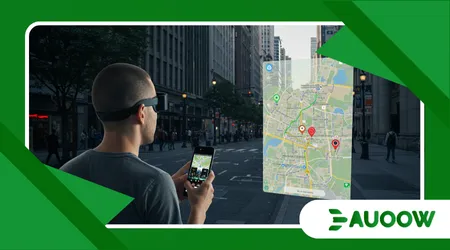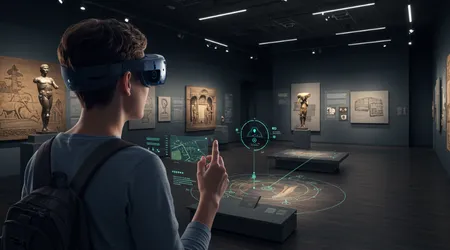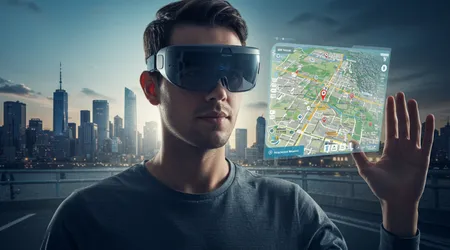How Augmented Reality Assists Users with Spatial Orientation

Augmented reality assists users with spatial orientation by seamlessly blending digital information with the physical world, enhancing how we navigate and interact with our surroundings.
Imagine stepping into a bustling city, your smartphone or AR glasses projecting real-time directions, highlighting landmarks, or even warning you about obstacles.
This isn’t sci-fi; it’s 2025, and augmented reality (AR) is transforming spatial awareness for everyone, from visually impaired individuals to urban explorers.
By overlaying contextual data onto real environments, AR empowers users to make sense of complex spaces with unprecedented clarity.
This article dives into how augmented reality assists users with spatial orientation, exploring its applications, benefits, and potential to redefine accessibility and innovation.
AR’s rise stems from its ability to bridge the gap between digital and physical realms. Unlike virtual reality, which immerses users in a fully simulated environment, AR enhances the real world with digital overlays, making it ideal for spatial tasks.
From navigation apps to assistive devices, AR’s role in spatial orientation is growing, driven by advancements in AI, 5G, and wearable tech.
According to Statista, the global AR market is projected to reach $198 billion by 2025, reflecting its expanding impact.
This article will unpack AR’s transformative power, offering practical examples, a fresh analogy, and a detailed look at its applications in assistive technology.
The Science Behind AR and Spatial Orientation
Spatial orientation involves understanding one’s position in a physical environment, a complex process relying on visual, auditory, and sensory cues.
Augmented reality assists users with spatial orientation by enhancing these cues with digital overlays, making navigation intuitive.
For instance, AR apps like Google Maps’ Live View project arrows onto real-world views, guiding users through busy streets. These overlays anchor digital information to physical spaces, improving situational awareness.
The brain processes spatial data through a combination of egocentric (self-centered) and allocentric (environment-centered) perspectives.
AR enhances both by providing real-time, context-aware information. For example, AR glasses can display a 3D map that adjusts as the user moves, reinforcing spatial relationships. This dynamic interaction reduces cognitive load, making navigation effortless.
++ How Blockchain Could Help with Assistive Device Distribution
Advancements in simultaneous localization and mapping (SLAM) technology allow AR devices to track user movement and map environments in real time.
This ensures digital overlays remain accurate, even in dynamic settings like crowded airports. By integrating AI, AR systems adapt to user needs, offering personalized guidance.
AR’s precision comes from sensors like gyroscopes, accelerometers, and cameras, which track motion and environment.
These enable AR to provide real-time feedback, such as highlighting a staircase for a visually impaired user. This fusion of tech and human perception is revolutionizing spatial navigation.

AR as an Assistive Technology for Accessibility
For individuals with disabilities, augmented reality assists users with spatial orientation by addressing sensory and mobility challenges.
Visually impaired users benefit from AR systems that convert visual data into auditory or haptic feedback.
For instance, Microsoft’s Soundscape app uses spatial audio to guide blind users through cities, describing landmarks via earbuds.
Consider Jane, a visually impaired student navigating a university campus. Her AR glasses emit audio cues, like “turn left in 10 meters,” while vibrating to warn of obstacles.
This empowers Jane to move confidently, reducing reliance on external assistance. Such innovations enhance independence and quality of life.
Also read: How OpenAI and Similar Tools Are Shaping Assistive Communication
AR also aids those with motor impairments. Wheelchair users can use AR apps to identify accessible routes, avoiding stairs or uneven terrain.
These apps overlay pathfinding data onto real-world views, ensuring safe navigation. This inclusivity redefines accessibility in public spaces.
The potential extends to cognitive disabilities. AR can simplify complex environments for individuals with autism or dementia, using visual cues to highlight safe paths. These tailored solutions showcase AR’s versatility in assistive technology.
In healthcare, AR supports spatial orientation during rehabilitation. Patients recovering from strokes use AR to practice navigating virtual spaces, rebuilding spatial awareness.
This therapeutic application underscores AR’s role in enhancing accessibility across diverse needs.
AR in Everyday Navigation and Urban Exploration
Beyond assistive tech, augmented reality assists users with spatial orientation in everyday scenarios, transforming how we explore cities and spaces.
Apps like AR City overlay historical facts or transit schedules onto urban landscapes, enriching the user experience. Picture a tourist in Rome, their AR glasses highlighting the Colosseum’s history as they approach.
Urban navigation benefits immensely from AR’s real-time capabilities. For example, Tesla’s AR-enhanced displays highlight parking spots in crowded lots, reducing driver stress.
This practical application demonstrates AR’s ability to simplify complex environments.
AR also gamifies exploration. Apps like Pokémon Go, while recreational, train users to interpret spatial cues in real-world settings. This playful approach hones spatial skills, blending fun with functionality.
Read more: How Smart Home Devices Improve Independence for People with Disabilities
In retail, AR helps customers navigate large stores. IKEA’s app, for instance, guides shoppers to specific aisles using AR overlays, streamlining the shopping experience. This efficiency boosts user satisfaction and store accessibility.
For cyclists or pedestrians in unfamiliar cities, AR wearables project bike lanes or pedestrian paths onto the real world. This real-time guidance enhances safety and confidence, making urban exploration seamless.
AR in Professional and Industrial Applications
In professional settings, augmented reality assists users with spatial orientation by streamlining complex tasks.
In architecture, AR allows designers to visualize 3D models on-site, ensuring accurate spatial planning. For example, an architect can overlay a building’s blueprint onto a construction site, verifying alignment.
Industrial maintenance benefits from AR’s precision. Technicians use AR headsets to overlay repair instructions onto machinery, navigating intricate components with ease. This reduces errors and speeds up processes, boosting efficiency.
Military applications leverage AR for battlefield navigation. Soldiers use head-mounted displays (HMDs) to view real-time tactical data, like enemy positions, overlaid on their field of view. This enhances situational awareness in high-stakes environments.
In aviation, AR assists pilots with spatial orientation during low-visibility conditions. Head-up displays (HUDs) project critical data, like runway markers, onto the cockpit view, improving safety. This application highlights AR’s life-saving potential.
Logistics workers use AR to navigate vast warehouses. AR glasses highlight optimal routes to items, reducing time spent searching. This efficiency underscores AR’s value in high-pressure professional settings.
The Future of AR in Spatial Orientation
Looking ahead, augmented reality assists users with spatial orientation by integrating with emerging technologies like 5G and AI.
5G’s low latency enables real-time AR updates, critical for dynamic environments like busy streets. This ensures seamless navigation experiences.
AI-driven AR will personalize spatial guidance further. Imagine AR glasses learning a user’s preferences, suggesting routes based on past behavior. This adaptability will make AR indispensable for daily navigation.
Wearable AR devices, like Google’s Android XR glasses, promise lightweight, intuitive designs. Unveiled at TED 2025, these glasses use AI to recall object locations, aiding spatial memory. Such innovations signal a future of ubiquitous AR.
Contact lenses with AR capabilities could revolutionize spatial orientation. By embedding displays into lenses, users could access navigation data discreetly, blending digital and physical worlds effortlessly.
However, challenges remain. High costs and cybersecurity concerns could hinder adoption. Addressing these will be key to making AR accessible to all, ensuring its transformative potential is realized.
Challenges and Ethical Considerations

Despite its promise, AR faces hurdles in delivering spatial orientation solutions. High costs limit access, particularly for assistive tech aimed at disabled users. Affordable hardware is crucial for widespread adoption.
Cybersecurity risks loom large. AR devices collect sensitive data, like location and user behavior, raising privacy concerns. Developers must prioritize secure systems to protect users.
Overreliance on AR could diminish natural spatial skills. Imagine a hiker lost without their AR device—could they navigate using traditional methods? Balancing tech and instinct is essential.
Ethical design is critical. AR must avoid overwhelming users with excessive information, which could cause cognitive overload. Thoughtful interfaces ensure clarity and usability.
Inclusivity demands attention. AR systems must accommodate diverse needs, from colorblind users to those with motor impairments. Universal design principles will drive equitable access.
A Fresh Analogy: AR as a Compass for the Digital Age
Think of AR as a modern compass, guiding users through the wilderness of physical and digital spaces.
Just as a compass points north, augmented reality assists users with spatial orientation by aligning digital cues with the real world.
This fusion creates a reliable guide, empowering users to navigate with confidence, whether in a city or a factory.
Practical Examples of AR in Action
Take Mark, a warehouse worker using AR glasses to locate inventory. The glasses overlay a glowing path to the correct shelf, cutting search time in half. This efficiency boosts productivity and reduces stress.
Similarly, Sarah, a blind pedestrian, uses an AR app that vibrates her phone to signal crosswalks. Paired with audio cues, it guides her through busy intersections, enhancing her independence.
Table: AR Applications for Spatial Orientation
| Application | Description | Example Use Case |
|---|---|---|
| Assistive Navigation | Audio/haptic feedback for accessibility | Guiding visually impaired users in cities |
| Urban Exploration | Overlays transit or historical data | AR City app for tourists |
| Industrial Maintenance | Step-by-step repair instructions | AR headsets for machinery repair |
| Retail Navigation | Guides shoppers to products | IKEA’s AR app for store navigation |
| Military Applications | Tactical data overlaid on battlefield | HMDs for soldiers’ situational awareness |
Why AR Matters Now
Why should we care about AR’s role in spatial orientation? In 2025, as cities grow denser and technology permeates daily life, navigating complex spaces demands innovative solutions.
AR not only enhances accessibility but also empowers professionals, explorers, and everyday users. Its ability to merge digital and physical worlds makes it a cornerstone of assistive technology and innovation, promising a future where no one is left lost.
By embracing AR, we’re not just navigating spaces we’re redefining how we interact with the world. From empowering the disabled to streamlining industries, AR’s impact is profound.
As we move forward, let’s ensure this technology remains inclusive, secure, and transformative, guiding us all toward a more connected future.
Frequently Asked Questions
How does AR improve spatial orientation for the visually impaired?
AR uses audio and haptic feedback to guide users, like Microsoft’s Soundscape app, which describes landmarks and obstacles, enhancing independence.
What devices support AR for navigation?
Smartphones, AR glasses (e.g., Xreal Air 2 Ultra), and headsets like Apple Vision Pro deliver AR navigation, with contact lenses on the horizon.
Are there privacy concerns with AR navigation?
Yes, AR devices collect location and behavioral data, requiring robust cybersecurity to protect user privacy and prevent misuse.
Can AR be used in professional settings?
Absolutely. AR aids architects, technicians, and soldiers by overlaying critical data, improving precision and efficiency in complex tasks.
Is AR affordable for widespread use?
Costs remain a barrier, but declining hardware prices and open-source platforms are making AR more accessible for assistive and everyday use.
